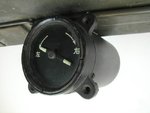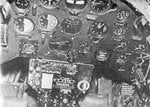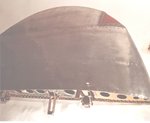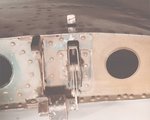Navigation
Install the app
How to install the app on iOS
Follow along with the video below to see how to install our site as a web app on your home screen.
Note: This feature may not be available in some browsers.
More options
You are using an out of date browser. It may not display this or other websites correctly.
You should upgrade or use an alternative browser.
You should upgrade or use an alternative browser.
Japanese Zero Instruments
- Thread starter ob'98
- Start date
Ad: This forum contains affiliate links to products on Amazon and eBay. More information in Terms and rules
More options
Who Replied?FLYBOYJ
"THE GREAT GAZOO"
I was wondering WTF that was!!!!!! 

ccheese
Member In Perpetuity
FLYBOYJ
"THE GREAT GAZOO"
That means its a "synchrophaser." Thanks for the translation!The letters on the face lower to the needle can read do-cho-kei that possibly means it was used to harmonize revolutions of the engines on the wings. Is that right?
FLYBOYJ
"THE GREAT GAZOO"
Correct...
DOUGRD
Staff Sergeant
After reading this thread last night I got curious and started looking in a couple of books I have on JNAF and JAAF camo markings and then back to the WWW. This is what I found...The Japanese character "T" with the small "I" means LEFT. The other "T" with the square obviously must mean RIGHT. (No brainer) After searching through loads of cockpit pictures on the WWW I found one that showed this indicator. It was in a Ki-45 type 2 Toryu (Nick). Since the "Nick" is a twin engine a/c and there was no other obvious purpose dedicated indicator I would say this one must be a Sync Indicator. So Micdrow and Ppopsie are correct. Let me add that I said it's a sync "indicator". It's not a synchrophaser, it only indicates the engine sync, it doesn't monitor and correct it.
DOUGRD
Staff Sergeant
R Leonard
Staff Sergeant
A6M2 instruments???
These are from A6M2 #4593 recovered from the Aleutians in 1942 . . . yes, that one.
First is the airspeed indicator, front and back. Note bottom row of characters on ID plate, second character from left is a propeller with the letters TS, as in the Tom Sopwith logo.
Next is the manifold pressure gauge, front and back; used to have that one mounted in my 66 Pontiac GTO
and last ,and just for laughs, some shots of the port wingtip. Note hinge device and uses of US and Japanese preservative primers.
All of these articles were in my father's possession from March 1944, when he retrieved them from the pile of junk that was the remains of the plane after it had been wrecked in February 1944, until July1986 when he donated them to the USN Museum in Anacostia, DC.
Sure wish he had asked me first (sigh).
Regards,
Rich
2223 20 Oct . . . fixed the pictures
These are from A6M2 #4593 recovered from the Aleutians in 1942 . . . yes, that one.
First is the airspeed indicator, front and back. Note bottom row of characters on ID plate, second character from left is a propeller with the letters TS, as in the Tom Sopwith logo.
Next is the manifold pressure gauge, front and back; used to have that one mounted in my 66 Pontiac GTO
and last ,and just for laughs, some shots of the port wingtip. Note hinge device and uses of US and Japanese preservative primers.
All of these articles were in my father's possession from March 1944, when he retrieved them from the pile of junk that was the remains of the plane after it had been wrecked in February 1944, until July1986 when he donated them to the USN Museum in Anacostia, DC.
Sure wish he had asked me first (sigh).
Regards,
Rich
2223 20 Oct . . . fixed the pictures
Attachments
I see the back of an instrument on top right is for the MAP. On the bottom is for the ASI.
On the ID can read; 1Go manifold air pressure 2Gata/ serial number and markings?/?Tokyo? KK Tanaka Keiki Seisaku-jo (Tanaka aviation instruments company).
#4593 Was that the one wrecked in a ground mishap?
On the ID can read; 1Go manifold air pressure 2Gata/ serial number and markings?/?Tokyo? KK Tanaka Keiki Seisaku-jo (Tanaka aviation instruments company).
#4593 Was that the one wrecked in a ground mishap?
R Leonard
Staff Sergeant
Gaak! you're right! Mixed them up when putting the images together. I'll fix that and repost, hopefully sometime tonight . . . have a social too-doo to run off to first.
Yes, 4593 was waiting for takeoff at North Island with Dick Crommelin in the driver's seat when a SB2C, which for some reason was not zig zagging while taxiing, came straight up behind him and proceeded to chop the poor thing to bits. Stopped just short of the cockpit when the Beast driver realized his prop was throwing metal in all direction. Crommelin was later lost in a mid-air over Hokkaido on 15 July 45 as CO of VF-88.
Crommelin was a USNA classmate of my father's and his cabinmate aboard USS Yorktown (CV-5) when they were in VF-42 through Coral Sea and in VF-3 at Midway.
My father flew 4593 in the fall of 1943 on four or five occasions. He was the guy who convined Jim Flatley and Uncle John Crommelin (Dick's older brother) to bring it east from Anacostia NAS and use it for training.
Don't let me forget to fix the photos. Thats what I get for splicing individual shots together. Interesting, the propeller with TS is also the Tanaka aviation instruments logo? Same as Tom Sopwith.
Regards,
Rich
Yes, 4593 was waiting for takeoff at North Island with Dick Crommelin in the driver's seat when a SB2C, which for some reason was not zig zagging while taxiing, came straight up behind him and proceeded to chop the poor thing to bits. Stopped just short of the cockpit when the Beast driver realized his prop was throwing metal in all direction. Crommelin was later lost in a mid-air over Hokkaido on 15 July 45 as CO of VF-88.
Crommelin was a USNA classmate of my father's and his cabinmate aboard USS Yorktown (CV-5) when they were in VF-42 through Coral Sea and in VF-3 at Midway.
My father flew 4593 in the fall of 1943 on four or five occasions. He was the guy who convined Jim Flatley and Uncle John Crommelin (Dick's older brother) to bring it east from Anacostia NAS and use it for training.
Don't let me forget to fix the photos. Thats what I get for splicing individual shots together. Interesting, the propeller with TS is also the Tanaka aviation instruments logo? Same as Tom Sopwith.
Regards,
Rich
GREAT story! I remembered to read the name Dick Crommelin in one or more of naval war books but I cannot remember the titles.
R Leonard, did your father ever mentioned about the size of the cockpit of Zero? I have been wondering the size was enough to hold American pilots.
I believe a thing in reverse order that is a Zero run into a Beast won't ever happen. Anyway flying in taildragger planes is absolute fun.
R Leonard, did your father ever mentioned about the size of the cockpit of Zero? I have been wondering the size was enough to hold American pilots.
I believe a thing in reverse order that is a Zero run into a Beast won't ever happen. Anyway flying in taildragger planes is absolute fun.
R Leonard
Staff Sergeant
The sure would make a great mantel piece R Leonard , but they are probably in a better place. At least lots of people get to enjoy them.
Yeah, but wouldn't the wing tip of an A6M look just great over the mantel? Dad always kept in the garage or the attic, depending where we were living. Guess I'll have to settle for my F4F clock.
Regards,
Rich
R Leonard
Staff Sergeant
. . . did your father ever mentioned about the size of the cockpit of Zero? I have been wondering the size was enough to hold American pilots.
He wasn't a real big guy, only about 5'8". He told me he did not find it particularly cramped.
Regards,
Rich
I basically agree. There's a section in "Japanese Aircraft Equipment" by Robert Mkesh on instruments that allows it to be refined it a bit more.On the ID can read; 1Go manifold air pressure 2Gata/ serial number and markings?/?Tokyo? KK Tanaka Keiki Seisaku-jo (Tanaka aviation instruments company).
'Go' is interpreted as 'mark' in this case, 'Gata' as 'model'
Interestingly, the Chinese-derived characters, called kanji in Japanese, on the gauge are in a traditional style similar to the Sino-Korean keyboard I'm using below (and which I hope appears correctly), not the modern simplified Japanese style.
First line: 一號吸入壓力計二型 =Mark 1 Intake Pressure Gauge Model 2
Second line: ト 第 304737 型 [anchor symbol]= 'to' (phonetic syllabary, not sure what it signifies here) No. 304737 [navy type].
Third line: 昭和 [illeg.]年[illeg.]月=Showa []year []month (Showa year is year of Hirohito's reign, 194[2]=Showa 17).
Fourth line: 東?-?-京? 株式會社 田中計器製作所=To?-?-kyo? Joint Stock Company ('KK') Tanaka Instrument Factory.
Joe
First line: 一號吸入壓力計二型 =Mark 1 Intake Pressure Gauge Model 2
Second line: ト 第 304737 型 [anchor symbol]= 'to' (phonetic syllabary, not sure what it signifies here) No. 304737 [navy type].
Third line: 昭和 [illeg.]年[illeg.]月=Showa []year []month (Showa year is year of Hirohito's reign, 194[2]=Showa 17).
Fourth line: 東?-?-京? 株式會社 田中計器製作所=To?-?-kyo? Joint Stock Company ('KK') Tanaka Instrument Factory.
Well done! Must be a great labor for the non-Japanese to type in these Kanji letters which are older and more complicated than today's and had been used on the days pre-and during WW2 or some later.
Today most of the younger generation people including me are almost unable to hand write these Kanji letters neatly and correctly.
Here Katakana "to" means #7 because the Katakana as well Hiragana were used to indicate the order in the old days, like alphabets or just numbers of today.
Hereby the order "I-ro-ha" was used, like;
I-RO-HA-NI-HO-HE-TO-CHI-RI-NU-....い、ろ、は、に、ほ、へ、と、ち、り、ぬ、・・・・47 letters in all.
I don't know how exactly the Navy seals or stamps consisted of but the anchor marking is typical on IJN equipment.
お疲れ様でした
Users who are viewing this thread
Total: 1 (members: 0, guests: 1)
Similar threads
- Replies
- 8
- Views
- 846






